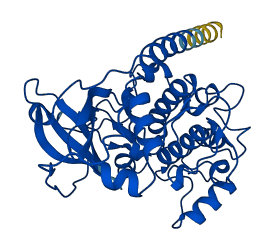Q8MJ44
Gene name |
PRKACA |
Protein name |
cAMP-dependent protein kinase catalytic subunit alpha |
Names |
PKA C-alpha |
Species |
Canis lupus familiaris (Dog) (Canis familiaris) |
KEGG Pathway |
cfa:403556 |
EC number |
2.7.11.11: Protein-serine/threonine kinases |
Protein Class |
|

Descriptions
The autoinhibited protein was predicted that may have potential autoinhibitory elements via cis-regPred.
Autoinhibitory domains (AIDs)
Target domain |
|
Relief mechanism |
|
Assay |
cis-regPred |
Accessory elements
183-203 (Activation loop from InterPro)
Target domain |
43-297 (Protein kinase domain) |
Relief mechanism |
|
Assay |
|
Autoinhibited structure

Activated structure

1 structures for Q8MJ44
| Entry ID | Method | Resolution | Chain | Position | Source |
|---|---|---|---|---|---|
| AF-Q8MJ44-F1 | Predicted | AlphaFoldDB |
No variants for Q8MJ44
| Variant ID(s) | Position | Change | Description | Diseaes Association | Provenance |
|---|---|---|---|---|---|
| No variants for Q8MJ44 | |||||
No associated diseases with Q8MJ44
4 regional properties for Q8MJ44
Functions
| Description | ||
|---|---|---|
| EC Number | 2.7.11.11 | Protein-serine/threonine kinases |
| Subcellular Localization |
|
|
| PANTHER Family | ||
| PANTHER Subfamily | ||
| PANTHER Protein Class | ||
| PANTHER Pathway Category | No pathway information available | |
7 GO annotations of cellular component
| Name | Definition |
|---|---|
| acrosomal vesicle | A structure in the head of a spermatozoon that contains acid hydrolases, and is concerned with the breakdown of the outer membrane of the ovum during fertilization. It lies just beneath the plasma membrane and is derived from the lysosome. |
| cytoplasm | The contents of a cell excluding the plasma membrane and nucleus, but including other subcellular structures. |
| mitochondrion | A semiautonomous, self replicating organelle that occurs in varying numbers, shapes, and sizes in the cytoplasm of virtually all eukaryotic cells. It is notably the site of tissue respiration. |
| nucleus | A membrane-bounded organelle of eukaryotic cells in which chromosomes are housed and replicated. In most cells, the nucleus contains all of the cell's chromosomes except the organellar chromosomes, and is the site of RNA synthesis and processing. In some species, or in specialized cell types, RNA metabolism or DNA replication may be absent. |
| perinuclear region of cytoplasm | Cytoplasm situated near, or occurring around, the nucleus. |
| plasma membrane | The membrane surrounding a cell that separates the cell from its external environment. It consists of a phospholipid bilayer and associated proteins. |
| sperm flagellum | A microtubule-based flagellum (or cilium) that is part of a sperm, a mature male germ cell that develops from a spermatid. |
6 GO annotations of molecular function
| Name | Definition |
|---|---|
| AMP-activated protein kinase activity | Catalysis of the reaction: ATP + a protein = ADP + a phosphoprotein. This reaction requires the presence of AMP. |
| ATP binding | Binding to ATP, adenosine 5'-triphosphate, a universally important coenzyme and enzyme regulator. |
| cAMP-dependent protein kinase activity | cAMP-dependent catalysis of the reaction: ATP + a protein = ADP + a phosphoprotein. |
| protein kinase A regulatory subunit binding | Binding to one or both of the regulatory subunits of protein kinase A. |
| protein serine kinase activity | Catalysis of the reactions: ATP + protein serine = ADP + protein serine phosphate. |
| protein serine/threonine kinase activity | Catalysis of the reactions: ATP + protein serine = ADP + protein serine phosphate, and ATP + protein threonine = ADP + protein threonine phosphate. |
3 GO annotations of biological process
| Name | Definition |
|---|---|
| cellular response to heat | Any process that results in a change in state or activity of a cell (in terms of movement, secretion, enzyme production, gene expression, etc.) as a result of a heat stimulus, a temperature stimulus above the optimal temperature for that organism. |
| protein kinase A signaling | A series of reactions, mediated by the intracellular serine/threonine kinase protein kinase A, which occurs as a result of a single trigger reaction or compound. |
| protein phosphorylation | The process of introducing a phosphate group on to a protein. |
6 homologous proteins in AiPD
| UniProt AC | Gene Name | Protein Name | Species | Evidence Code |
|---|---|---|---|---|
| P00517 | PRKACA | cAMP-dependent protein kinase catalytic subunit alpha | Bos taurus (Bovine) | PR |
| P16911 | Pka-C2 | cAMP-dependent protein kinase catalytic subunit 2 | Drosophila melanogaster (Fruit fly) | PR |
| P17612 | PRKACA | cAMP-dependent protein kinase catalytic subunit alpha | Homo sapiens (Human) | PR |
| P05132 | Prkaca | cAMP-dependent protein kinase catalytic subunit alpha | Mus musculus (Mouse) | PR |
| P36887 | PRKACA | cAMP-dependent protein kinase catalytic subunit alpha | Sus scrofa (Pig) | PR |
| P21137 | kin-1 | cAMP-dependent protein kinase catalytic subunit | Caenorhabditis elegans | PR |
| 10 | 20 | 30 | 40 | 50 | 60 |
| MGNAAAKKGS | EQESVKEFLA | KAKEDFLKKW | ENPAQNTAHL | DQFERIKTLG | TGSFGRVMLV |
| 70 | 80 | 90 | 100 | 110 | 120 |
| KHKETGNHFA | MKILDKQKVV | KLKQIEHTLN | EKRILQAVNF | PFLVKLEFSF | KDNSNLYMVM |
| 130 | 140 | 150 | 160 | 170 | 180 |
| EYVPGGEMFS | HLRRIGRFSE | PHARFYAAQI | VLTFEYLHSL | DLIYRDLKPE | NLLIDQQGYI |
| 190 | 200 | 210 | 220 | 230 | 240 |
| QVTDFGFAKR | VKGRTWTLCG | TPEYLAPEII | LSKGYNKAVD | WWALGVLIYE | MAAGYPPFFA |
| 250 | 260 | 270 | 280 | 290 | 300 |
| DQPIQIYEKI | VSGKVRFPSH | FSSDLKDLLR | NLLQVDLTKR | FGNLKNGVND | IKNHKWFATT |
| 310 | 320 | 330 | 340 | ||
| DWIAIYQRKV | EAPFIPKFKG | PGDTSNFDDY | EEEEIRVSIN | EKCGKEFCEF |